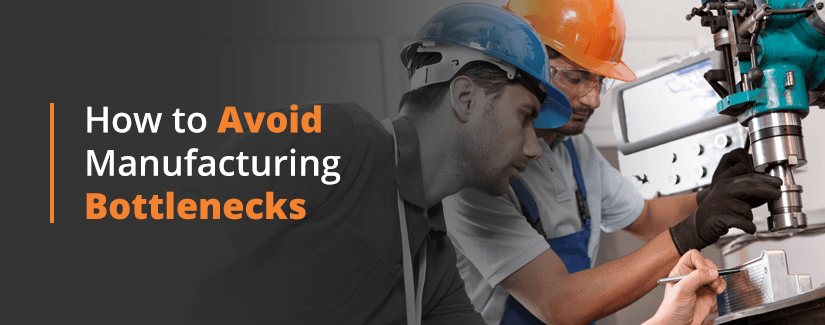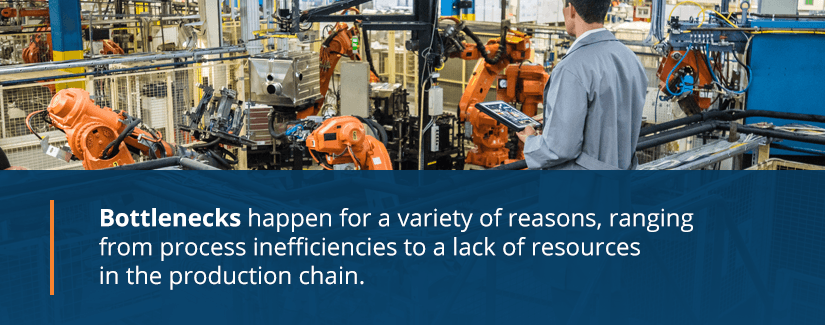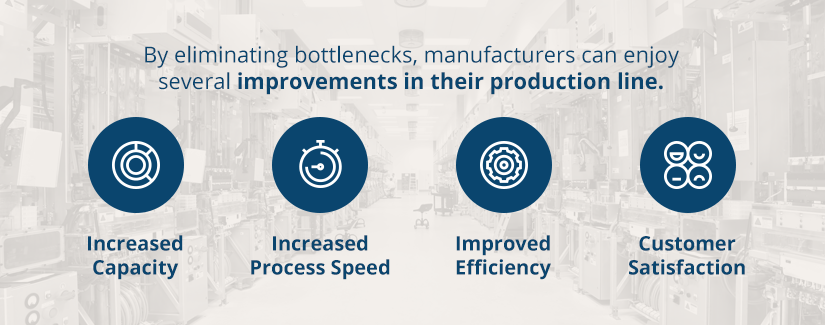How to Avoid Manufacturing Bottlenecks

No matter how efficient a production line is, there may still be a machine or process step that cannot keep up with the capacity of the rest of the system. This bottleneck in the production chain can limit the total output of the manufacturing system, as well as negatively impacting facility efficiency and revenue. However, there are many strategies manufacturers can use to identify and eliminate bottlenecks to boost their production capacity and profits.
What Is a Bottleneck?
A manufacturing bottleneck is a process within the production line that limits the maximum throughput of the entire system. Manufacturing systems are typically designed with room for scalability, meaning that machines are not operating at 100 percent capacity. However, if one piece of equipment is working at its highest capacity, while others are running at lower than their maximum capacity, this machine is the bottleneck that limits the total ability of the production chain. The throughput of the system can only increase as high as the capacity of the bottleneck.
Bottlenecks can be either short-term or long-term, depending on the cause. A short-term bottleneck can occur when a skilled operator is temporarily absent or a machine breaks down and must wait for a repair. A long-term bottleneck — also known as a constraint — occurs when a machine is not efficient enough or cannot meet the capacity of other equipment in the production line. Long-term bottlenecks regularly happen during normal operation and are typically more challenging to overcome than temporary, short-term bottlenecks.
In almost every manufacturing system, there is at least one constraint that limits the capacity of the system. These long-term bottlenecks disrupt the flow of the production chain by causing inventory to accumulate before the bottleneck process. The lower output of the bottleneck also causes machines after the bottleneck to operate less efficiently as they must wait for materials to move through the bottleneck process. By stalling the production chain, bottlenecks can result in increased downtime, decreased efficiency, lack of scalability and loss in revenue.
Why Do Bottlenecks Occur?

Bottlenecks happen for a variety of reasons, ranging from process inefficiencies to a lack of resources in the production chain. In some cases, a bottleneck may result from a factor outside of your production facility, such as a shortage in supply. Here are a few main causes of bottlenecks in manufacturing systems.
- Low machine capacity: If inventory is entering a process stage more quickly than machines can process those materials, a bottleneck can occur. Materials will accumulate before the bottleneck, stalling processes that follow. Equipment with low capacity will limit the total throughput of the system.
- Poor machine efficiency: In some instances, a machine may have the capacity available to keep up with input, but is not operating at full efficiency. The reasons for this can be due to lack of optimization in workflow, poor machine maintenance or design flaws that reduce the capacity of the bottleneck process.
- Equipment breakdowns: If a machine breaks down, it can cause a temporary bottleneck while someone is repairing it. While equipment failure typically only creates short-term bottlenecks, equipment that frequentlymalfunctions or breaks down can cause continued problems for production capacity.
- Insufficient number of machines: Bottlenecks may occur at a production stage if not enough machines are in place to match capacity for that process. Poor facility design is often the reason for this, and often, the best way to remediate this is by implementing more equipment to manage that process.
- Lack of workers: Similarly to a lack of machines, a shortage of capable operators to manage a process stage can also cause a bottleneck at that stage. New or improperly trained employees can also slow down processes and lead to a bottleneck in the production chain.
- Supply shortage: Unexpected bottlenecks can occur when there is a shortage of supply upstream. Depending on the duration of the shortage, manufacturers may need to seek additional suppliers or change suppliers to meet customer demand.
By understanding the various causes of manufacturing bottlenecks, companies can better identify constraints in their production line.
How to Identify Manufacturing Bottlenecks
In almost every manufacturing facility, at least one bottleneck process will limit the production chain throughput. However, finding the most critical bottleneck can be challenging in a production facility with many process stages or multiple product paths. Here are a few tips for identifying bottlenecks in your production line.
- Talk to machine operators: If a plant manager does not spend a lot of time on the production floor, it may be difficult for them to identify potential bottlenecks. Talking to operators can be a great place to start, as they will typically have a good sense of which processes hold up production regularly.
- Look for product accumulation: Another straightforward way to identify a manufacturing bottleneck is to look for areas where materials accumulate. Often, inventory will pile up before a bottleneck as it waits for processing.
- Calculate process step capacities: If there is not an apparent accumulation of materials before a process step, determine the capacity of each process step to identify the stage with the lowest capacity. Be sure to calculate the total average capacity of the process step, rather than the individual ability of a machine or operator.
- Calculate process step cycle times: Taking a similar approach to calculating capacities, manufacturers can look at the cycle time of each process step to identify slow processes in the production line.

- Pay attention to machine downtime: Machines right after a bottleneck in the manufacturing process frequently have excessive downtime and experience extended wait times. Looking for process steps that experience greater downtime can help identify bottlenecks.
- Look for weak links in the production line: If there is a process step in your production line that often requires extra attention during busy times, this area is likely a bottleneck. Machines at this process step may not be optimized to their highest capacity, or workers may require additional training to operate the equipment more efficiently.
Manufacturing facilities with multiple product paths face additional challenges for identifying bottlenecks. To locate the most critical bottleneck, address each product path individually and identify bottlenecks in that process. Then, examine the system as a whole and determine which bottleneck, when removed, will have the most significant impact on overall throughput. When possible, manufacturers should aim to eliminate all critical bottlenecks across multiple product paths.
Why Is It Important to Address Bottlenecks?
Bottlenecks can have detrimental impacts on the efficiency, productivity and profitability of a production facility. Manufacturing bottlenecks limit the capacity of a production line, resulting in decreased revenue. To meet customer demand, manufacturers may need to rely on additional overtime hours or outsource the capacity they cannot meet due to the bottleneck process. When products accumulate between process steps, this also requires extra storage for surplus inventory, as well as wasted work hours as machines must experience more downtime waiting for inventory.

By eliminating bottlenecks, manufacturers can enjoy several improvements in their production line.
- Increased capacity: Improving bottlenecks allows the ability of the entire system to increase by increasing the capacity of the bottleneck process. For example, if a bottleneck process has a capacity of 100, the throughput of the entire system can only be 100. However, if the bottleneck capacity increases to 150, the capacity of the entire system rises to 150 as well.
- Increased process speed: In addition to limiting the capacity of a production chain, bottlenecks also slow down processing time and create extra downtime between processes. By eliminating bottlenecks, supply can move more quickly through the manufacturing process. For facilities that are already meeting demand, improved process time could mean fewer operating hours are necessary, saving energy and money.
- Improved efficiency: A manufacturing bottleneck causes other machines in the production line to operate less efficiently than their potential. When machines experience long wait times and increased downtime, this can result in wasted energy and resources. Eliminating bottlenecks improves the efficiency of both the bottleneck process and the entire supply chain.
- Improved customer satisfaction: When you improve the throughput and process time of your facility, you also pass on those benefits on to your customers through faster order fulfillment and fewer out of stock items.
By leaving long-term bottlenecks unaddressed, manufacturers may be missing out on the opportunity to boost their production capacity. But by eliminating bottlenecks, companies can scale their business, expand their market and increase their revenue.
Which Is an Example of the Bottleneck Effect?
Manufacturing bottlenecks will look different in every production chain, but often occur in similar situations. Here are a few bottleneck examples that may help you identify bottlenecks in your manufacturing system.
1. Bottleneck Due to Low Machine Capacity
A small production facility uses four different machines to transform raw material into a final product. Most of the equipment works at a high capacity, processing 100 units an hour. However, the third machine in the production line can only process 50 units each hour. The result is that the total output of the production system is only 50 units an hour, even though the first two machines in the production line process 100 units hourly. Materials accumulate beside the third machine, and the fourth machine in the production line operates at just 50 percent of its potential capacity as it waits for everything to pass through the bottleneck machine.
2. Bottleneck Due to Machine Breakdown
A manufacturing facility has three machines working at maximum capacity to process 150 units every hour at a single process step. When one of these machines breaks down, that process step now only has a capacity of 100 units per hour. With input continuing at the average pace of 150 units an hour, 400 units will accumulate at that process step in the course of a single eight-hour shift. While the machine is under repair, operators must work overtime to meet the capacity demand and prevent inventory from accumulating.
3. Bottleneck Due to Operator Absence
A facility requires specialized machinery in the capable hands of a highly skilled operator. The facility only has three operators on staff who can run that machine. If one of the operators must be absent due to an unexpected medical leave, the facility can no longer operate the machinery full-time. That can cause a bottleneck as materials stall at this process step when there is not a skilled operator available to operate the specialized machine.
How Do You Stop Bottleneck Production?
There are several steps manufacturers can take to eliminate bottlenecks in their production line. After they identify a bottleneck and its cause, manufacturers can implement solutions to increase capacity, increase process speed and improve machine efficiency. Here are a few ways to stop production line bottlenecks.
- Reduce non-value activities: Before making any expensive changes or overhauls to your production line, consider ways to improve the efficiency and capacity of the bottleneck process itself. For example, eliminating or reducing any non-value activities the bottleneck machine currently performs can help optimize its output.
- Increase uptime of the bottleneck: Changeovers and setup time between cycles can limit the capacity of a machine, resulting in a bottleneck. Aim to increase the uptime of bottleneck machines by limiting changeovers and only performing maintenance during regular downtime. However, manufacturers must also take caution not to overload the equipment to result in a breakdown or shorter machine lifespan.
- Provide buffer inventory before the bottleneck: Manufacturers can also increase uptime by ensuring there is always a small surplus of materials before the bottleneck. In the event of an unexpected supply shortage, the bottleneck process can continue operating at a continuous duty cycle. In a 2016 study of a mattress manufacturing line, production increased by nearly 89 percent with the addition of two buffer stocks.
- Implement quality checks before the bottleneck: Bottleneck machines are already operating at a lower capacity than others in the production line, and if workers do not perform quality checks before the bottleneck process, it wastes even more time and energy when damaged or poor-quality materials pass through the bottleneck process. Implementing a quality check before the bottleneck ensures only good-quality parts get sent through the bottleneck process.

- Perform effective maintenance: Badly maintained machines can lead to poor operation, resulting in a bottleneck. Equipment failure can also lead to downtime and inventory accumulation at a process step. By keeping machines well-maintained, they can operate at optimal efficiency to avoid manufacturing bottlenecks.
- Consider design improvements: Design alterations or workflow improvements in the manufacturing process can eliminate bottlenecks. For example, a 2012 case study of a tractor manufacturing company revealed bottlenecks occurred because workers used multiple tools for the same function. By streamlining the process to use just one tool instead of three, the company reduced cycle time from 8.2 minutes to 1.9 minutes, and total production increased.
- Increase the number of machines: In some instances, a bottleneck will remain even after companies find a way to optimize a machine’s efficiency. Manufacturers may need to invest in additional equipment to increase the capacity at the process step that is causing a bottleneck.
- Offload work to other machines: If other equipment is not operating at full capacity in your facility, consider if you can offload some of the bottleneck processes to underused machines.
- Hire or train more operators: If a shortage of workers is the cause of a bottleneck, manufacturers may need to hire new operators or cross-train their other workers so they can operate the bottleneck machine.
- Consider process automation: Machines with greater automation can often run at faster speed and for longer-duty cycles than machines that require a human operator. Think about whether your manufacturing system may benefit from the investment in process automation to reduce bottlenecks.
- Consider outsourcing: In some cases, it may be more cost-effective to offload some work to other manufacturers than to purchase additional equipment or alter your production line. By outsourcing work at the bottleneck process, you can increase overall production capacity.
- Consider subcontracting or selling excess equipment: While this option will not increase the capacity of your facility, it can increase revenue to make up for losses from the bottleneck. If other machines in your facility have excess operating capacity or some machines are sitting unused, consider subcontracting these machines to other companies or selling them for additional revenue.
By taking action to improve process efficiency or increase capacity at the bottleneck process, manufacturers can effectively eliminate bottlenecks to boost output and increase revenue.
Equipment Repair Services From Global Electronic Services

Manufacturing bottlenecks can severely impact the efficiency and productivity of a production chain. However, by taking steps to optimize production line efficiency and eliminate bottlenecks, manufacturers can enjoy smoother operations, increased output and higher profits.
If your production facility is experiencing bottlenecks caused by poor operation or frequent machine breakdowns, contact Global Electronic Services for industrial equipment repair. We offer fast and efficient repair services for all your repair needs — including AC and DC motors, servo motors, industrial electronics, hydraulics and pneumatics. Contact us or fill out an online form to request a free quote for industrial equipment repair from Global Electronic Services.